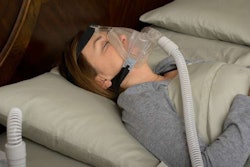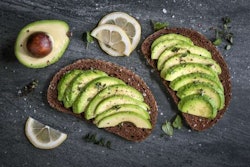Trucking isn’t conducive to a healthy lifestyle without a lot of planning and work, but that doesn’t mean it’s impossible for drivers to be healthy.
Registered dietitians Sharon Madalis and April Rudat are two experts on trucker health and the authors of the book “Truck Drivers: Stop Your Job From Killing You! The Dietitians’ Guide to Smart Eating and Healthy Living for Truckers.” They hosted a She Drives Trucks Facebook chat Nov. 30 and responded to trucker-submitted health questions. The questions covered a variety of topics.

Trucker Jennifer Cordero asked, “How safe are the Ketogenic, low carb/high fat or low carb/high protein diets?”
Madalis: “Most fad diets are safe in the short term. Some people like them because they can be simple to follow and you may see some quick weight loss. However, long term these are not recommended. Especially if you get yourself in the cycle of loss and regain. Look for plans that encourage all food groups, promotes exercise and changing eating behaviors.”
Rudat: “Low carb diets may produce weight loss in the short-term, but carbohydrates are the MAIN source of energy for our bodies, are the ONLY source of fuel for our brains, protect muscles, regulate the sugar circulating in our blood so cells get the energy they need, provide nutrients to help friendly bacteria digest food, help with absorption of calcium, may help lower cholesterol and regulate blood pressure, and contains antioxidants. Interestingly, as people start to feel deprived and denied of pleasurable foods (carbs), they often can’t stop thinking of them. This can lead to a research term called “disinhibition,” which means that a person who has not allowed themselves to eat certain foods thinks about and craves these foods, which can lead to BINGE eating. Balance is the answer! All foods can fit in moderation. If you want a brownie, have ONE brownie! Be sure you are having the brownie only when hungry and not to soothe yourself with food.”
Lovina Kauffman asked, “What is your opinion on the paleo way of eating?
 April Rudat
April RudatRudat: “The paleo diet can be considered unbalanced since it does not include dairy foods or grain foods. Dairy foods provide excellent delivery of calcium to the bones. Grain foods provide a satisfied feeling when eating due to their fiber and also help with normal digestion and going to the bathroom. Carbohydrates are the main fuel for the brain and even assist with muscle recovery, so without enough carbohydrates, which are found in both grains and dairy, people may experience fatigue, poor sleep quality, issues with sex drive, and issues with attention and focus.”
Trucker Cinda Kelly recently slipped in diesel fuel and fractured her fibula. She asked, “What diet will help the broken bone heal better?”
Madalis: “With any fracture, make sure you are getting enough protein in your diet (fish, meat, eggs, peanut butter, milk, cheese, yogurt, soy products like tofu). Also, it is important to make sure you have vitamins and minerals in your diet that you can get from all food groups but especially fruits and vegetables. If your appetite is poor, sometimes supplementing with nutritional drinks like Boost, Ensure, Carnation Breakfast Essentials can be beneficial.”
Rudat: “You can get protein from so many other sources — beans, eggs, chicken, fish, nuts/seeds/peanut butter — as Sharon mentioned. Be sure to get a protein source with each meal. Supplement your dairy with soy milk or almond milk – 8 oz has 45% of your calcium intake. If your doctor agrees, calcium with vitamin D is a good idea if your diet is lacking in both. To help with the swelling, be sure to stay hydrated. I would also take breaks as you are able — to walk around and stretch.”
Lisa Noel wanted to know, “What can I change in my diet so I don’t have to pee every three hours?”
Rudat: “It is a good idea to have your blood sugars tested at a lab. Be sure to fast for 12 hours. In the meantime, peeing every 3 hours may also mean you are well hydrated – which is a good thing – but a bad thing for your occupation! I would also think about your caffeine intake — caffeine is a natural diuretic — which means that it can make you pee more, especially in excess. I would limit caffeine throughout your shift to help with this. Also, adequate hydration is often determined by urine color — aim for a pale-yellow, straw color or clear-ish color.”
Theresa Hutchison said she has been having a difficult time balancing drive time, rest time and health with safety. Her breaks occur during the night. She asked, “How do I get exercise and while still being able to keep safe out here?”
 Sharon Madalis
Sharon MadalisMadalis: “‘Indoor exercises’ to play it safe – if you have space in the rig, just marching in place to music or while watching tv, small mini trampolines to just walk/run in place, using small hand weights or Therabands for strength training. If you feel safe, walking around a big rig about 32 times is one mile.
Now there are Apps – one I just learned of is Swork It (Simply Work It) – has prebuilt work outs for all parts of the body that can be done in small spaces.”
Sandra Starling wanted to know, “What foods are easy to make on the road with limited resources that are healthy and have good stay power?”
Rudat: “Food combinations create staying power. If you check out: www.ChooseMyPlate.org, you will see the MyPlate model. The MyPlate recommends fruits and vegetables, which give you fiber – and fiber helps you feel full. Fill half your plate with fruits and vegetables. Then, combine fruits and vegetables with 1/4 of your plate as grains, 1/4 of your plate as protein, and a serving of dairy, which also has protein. For your grains, on 1/4 of the plate, choose whole grain foods like whole grain breads, pasta, or rice. For your protein, on 1/4 of the plate, choose lean sources like chicken and turkey, fish, beans, nuts/seeds/nut butters, or eggs. Choose red meats like beef, pork, veal, or lamb less often — twice a week or less. Choose fish more often — twice a week or more. When you pair fiber (fruits/veggies/whole grains) with protein (meats/dairy foods), you will feel 4-5 hours of fullness. Choose a small plate for instant portion control! It takes about 20-25 minutes to feel fullness, so wait for your brain to catch the signal from your stomach to see if you need seconds!”
Maxine Belcher Carter wanted to know examples of fat burning and energy saving goods.
Madalis: “Good question that we get a lot. Unfortunately many fad diets lead you to believe that if you eat a special way or certain food, you’ll lose weight. The best foods to eat to get energy and manage your weight are from all the food groups – lean proteins, whole grains, fruits, vegetables, and low fat dairy. I highly recommend MyPlate – lots of good information at choosemyplate.gov. Along with that, getting regular physical activity as much as possible to burn the calories you take in. Wish I had a miracle food for fat burning to tell you but there is none!”
Joann Krause’s question was about staying hydrated. She asked, “Is ice a good source of water consumption?”
Madalis: First of all, hoping you’re not craving ice as that is related to a particular condition. If it’s just that you like ice, totally a good way to get fluids in. Just be careful of your teeth of course!









